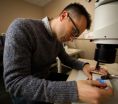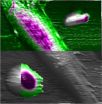(Press-News.org) In 2009, the American Diabetes Association (ADA) recommended that Hemoglobin A1c be exclusively used for the diagnosis of diabetes in children. The simple test measures longer-term blood sugar levels -- without requiring patients to fast overnight. However, a new U-M study has shown that these tests are not very accurate in children.
"We found that Hemoglobin A1c is not as reliable a test for identifying children with diabetes or children at high risk for diabetes compared with other tests in children," says Joyce M. Lee, M.D., M.P.H., lead author of the study and a pediatric endocrinologist at U-M's C.S. Mott Children's Hospital. "In fact, it failed to diagnose two out of three children participating in the study who truly did have diabetes."
Although tests that require patients to fast are the most accurate tests, they are difficult to obtain in clinical practice, highlighting the need for improved nonfasting testing strategies.
Due in part to high rates of childhood obesity, the Centers for Disease Control estimates that approximately 2.5 million children in the U.S. currently qualify for diabetes screening.
The study, published online ahead of print in the journal Diabetes Care, tested 254 overweight children using both fasting and non-fasting methods. Researchers found that the recommended test, Hemoglobin A1c, missed more cases of pre-diabetes or diabetes compared to other tests.
Participants in the study were defined as having prediabetes or diabetes based on a gold standard test. They were first tested using the Hemoglobin A1C test. After fasting for 12 hours, they returned on a separate day and were tested using a fasting method.
Based on the results, researchers urge that a nonfasting one-hour glucose challenge test, or a random glucose, may be promising methods for identifying children with prediabetes or diabetes.
"Other pediatric organizations, like the American Academy of Pediatrics, have not endorsed the use of HbA1c yet. However, there is concern that should they endorse it, more and more providers would use these testing methods, leading to an increase in missed diagnoses in the pediatric population," says Lee.
Researchers intend to use their data to drive future recommendations about screening for diabetes.
"We are currently studying whether the promising nonfasting tests, including the 1-hour glucose challenge test or the random glucose, could be used in combination with clinical characteristics to better identify which children have prediabetes or diabetes," says Lee.
###
Additional Authors: Achamyeleh Gebremariam, M.S, En-Ling Wu, B.A., Jennifer LaRose, B.S., James G. Gurney, Ph.D.
Citation: doi
Disclosures: None.
American Diabetes Association's preferred testing method fails to identify kids with diabetes
U-M study shows recommended test, Hemoglobin A1c, fails to identify children with diabetes or those at risk
2011-11-22
ELSE PRESS RELEASES FROM THIS DATE:
Human, artificial intelligence join forces to pinpoint fossil locations
2011-11-22
In 1991, a team led by Washington University in St. Louis paleoanthropologist Glenn Conroy, PhD, discovered the fossils of the first — and still the only — known pre-human ape ever found south of the equator in Africa after only 30 minutes of searching a limestone cave in Namibia.
Traditionally, fossil-hunters often could only make educated guesses as to where fossils lie. The rest lay with chance — finding the proverbial needle in a haystack.
"I don't want to say it's total luck," says Conroy, professor of physical anthropology in Arts & Sciences, "but it's a combination ...
New research on body parts' sensitivity to environmental changes
2011-11-22
Research by a team of Michigan State University scientists has shed new light on why some body parts are more sensitive to environmental change than others, work that could someday lead to better ways of treating a variety of diseases, including type 2 diabetes.
The research, led by assistant zoology professor Alexander Shingleton, is detailed in the recent issue of the Proceedings of the Library of Science Genetics.
In particular, Shingleton is studying the genetics of fruit flies and zeroing in on why some of the insects' body parts will grow to full size even when ...
PG Los Angeles Auto Glass Replacement and Repair Company, Now Offers Discounted Services
2011-11-22
For most Californians, a vehicle is not just a mode of transportation. Automobiles are an investment, a daily asset, and a necessary tool that many rely on. This is why it can become a major headache when those minor cracks and dings begin to crop up the windshield or other pieces of auto glass. For those that have had enough of unsightly and unsafe auto glass, there is now a great solution. Los Angeles auto glass repair is now easier and more affordable than ever as one of the most trusted local companies, PG Auto Glass, is offering a 10% discount on all of their services.
Auto ...
New study identifies novel role for PEA-15 protein in cancer growth
2011-11-22
HONOLULU—A new study from the University of Hawaii Cancer Center reveals that PEA-15, a protein previously shown to slow ovarian tumor growth and metastasis, can alternatively enhance tumor formation in kidney cells carrying a mutation in a cancer-promoting gene called H-Ras.
The H-Ras oncogene is mutated in many human malignancies, and previous reports have shown the ability of H-Ras to contribute to the development, proliferation and metastasis of these tumors. Conversely, PEA-15 had been reported to inhibit tumor cell proliferation and metastasis by opposing H-Ras ...
Chew gum, lose weight
2011-11-22
Most people understand that serious weight loss requires changing attitudes toward what they eat and how often they exercise. But, what if the process could be aided by simply chewing a stick of gum after meals? That's the question a team of scientists, led by Syracuse University chemist Robert Doyle, is trying to answer. In a groundbreaking new study, Doyle's team demonstrated, for the first time, that a critical hormone that helps people feel "full" after eating can be delivered into the bloodstream orally.
Doyle's study was published online Nov. 4, 2011 in the American ...
New culprit found in Lou Gehrig's disease
2011-11-22
CHICAGO --- Following a major Northwestern Medicine breakthrough that identified a common converging point for all forms of amyotrophic lateral sclerosis (ALS and Lou Gehrig's disease), a new finding from the same scientists further broadens the understanding of why cells in the brain and spinal cord degenerate in the fatal disease.
Less than three months ago, Northwestern research found that the crucial recycling system for cells in the brain and spinal cord was broken in people with ALS. And one mutated gene had a key role. Like a loafing worker, it wasn't doing its ...
Van Andel Institute study may lead to better, safer drug for diabetes
2011-11-22
Grand Rapids, Mich. (November 21, 2011) A Van Andel Research Institute (VARI) study published recently in the Journal of Biological Chemistry reveals that a natural fatty acid can serve as a regulator of blood sugar levels, which may have important applications in designing better and safer drugs for diabetes treatment.
According to the U.S. Center for Disease Control and Prevention (CDC), nearly 26 million Americans have diabetes, and current drugs commonly used to treat the disease sometimes have unwanted side effects.
The study found that decanoic acid, a saturated ...
New projection shows global food demand doubling by 2050
2011-11-22
Global food demand could double by 2050, according to a new projection by David Tilman, Regents Professor of Ecology in the University of Minnesota's College of Biological Sciences, and colleagues, including Jason Hill, assistant professor in the College of Food, Agricultural and Natural Resource Sciences.
Producing that amount of food could significantly increase levels of carbon dioxide and nitrogen in the environment and cause the extinction of numerous species. But this can be avoided, the paper shows, if the high-yielding technologies of rich nations are adapted ...
New medical, research tool possible by probing cell mechanics
2011-11-22
WEST LAFAYETTE, Ind. - Researchers are making progress in developing a system that measures the mechanical properties of living cells, a technology that could be used to diagnose human disease and better understand biological processes.
The team used an instrument called an atomic force microscope to study three distinctly different types of cells to demonstrate the method's potentially broad applications, said Arvind Raman, a Purdue University professor of mechanical engineering.
For example, the technique could be used to study how cells adhere to tissues, which is ...
Future prostate cancer treatments might be guided by math
2011-11-22
COLUMBUS, Ohio – Scientists have designed a first draft of a mathematical model that someday could guide treatment decisions for advanced prostate cancer, in part by helping doctors predict how individual patients will respond to therapy based on the biology of their tumors.
These decisions would apply to treatment of cancer that has already spread beyond the prostate gland or that has recurred after initial treatments, such as surgery or radiation. Patients with this more advanced prostate cancer receive a therapy called androgen ablation, which inhibits production of ...
LAST 30 PRESS RELEASES:
Interaction of climate change and human activity and its impact on plant diversity in Qinghai-Tibet plateau
From addressing uncertainty to national strategy: an interpretation of Professor Lim Siong Guan’s views
Clinical trials on AI language model use in digestive healthcare
Scientists improve robotic visual–inertial trajectory localization accuracy using cross-modal interaction and selection techniques
Correlation between cancer cachexia and immune-related adverse events in HCC
Human adipose tissue: a new source for functional organoids
Metro lines double as freight highways during off-peak hours, Beijing study shows
Biomedical functions and applications of nanomaterials in tumor diagnosis and treatment: perspectives from ophthalmic oncology
3D imaging unveils how passivation improves perovskite solar cell performance
Enriching framework Al sites in 8-membered rings of Cu-SSZ-39 zeolite to enhance low-temperature ammonia selective catalytic reduction performance
AI-powered RNA drug development: a new frontier in therapeutics
Decoupling the HOR enhancement on PtRu: Dynamically matching interfacial water to reaction coordinates
Sulfur isn’t poisonous when it synergistically acts with phosphine in olefins hydroformylation
URI researchers uncover molecular mechanisms behind speciation in corals
Chitin based carbon aerogel offers a cleaner way to store thermal energy
Tracing hidden sources of nitrate pollution in rapidly changing rural urban landscapes
Viruses on plastic pollution may quietly accelerate the spread of antibiotic resistance
Three UH Rainbow Babies & Children’s faculty elected to prestigious American Pediatric Society
Tunnel resilience models unveiled to aid post-earthquake recovery
Satellite communication systems: the future of 5G/6G connectivity
Space computing power networks: a new frontier for satellite technologies
Experiments advance potential of protein that makes hydrogen sulfide as a therapeutic target for Alzheimer’s disease
Examining private equity’s role in fertility care
Current Molecular Pharmacology achieves a landmark: real-time CiteScore advances to 7.2
Skeletal muscle epigenetic clocks developed using postmortem tissue from an Asian population
Estimating unemployment rates with social media data
Climate policies can backfire by eroding “green” values, study finds
Too much screen time too soon? A*STAR study links infant screen exposure to brain changes and teen anxiety
Global psychiatry mourns Professor Dan Stein, visionary who transformed mental health science across Africa and beyond
KIST develops eco-friendly palladium recovery technology to safeguard resource security
[Press-News.org] American Diabetes Association's preferred testing method fails to identify kids with diabetesU-M study shows recommended test, Hemoglobin A1c, fails to identify children with diabetes or those at risk



